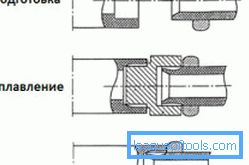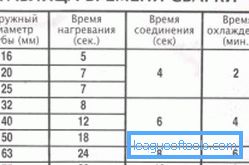Soldering technology of polypropylene pipes
Soldering polypropylene pipes occurs in a fairly short time, this is the most attractive side of a polypropylene pipe. Due to the low price, manufacturability and ease of docking, she took a leading position among pipes made of competing materials. It is mainly used when laying water supply and partly thermal engineering network. And let the strength be inferior to communications from metal pipes, but, undertaking repairs in an apartment or house, preference is given to this material. Pipes securely, firmly and quickly connected by soldering in minutes.

Polypropylene pipes are becoming increasingly popular due to ease of installation and reliability.
Types of polypropylene pipes
The plastic used to manufacture the product is high strength. It does not rust, does not accumulate salt, and it does not stick to calcareous growths. Networks made of polypropylene are designed for a long service life (up to 50 years). In fact, the service life of pipelines is not limited, if there is no excess of technical conditions of operation by temperature or pressure. The material of parts is able to work for a long time at a sufficiently high pressure at a low temperature of the liquid, and vice versa.

Table data on the various categories of polypropylene pipes.
Polypropylene pipes are produced in four color types, the color means nothing but color. Polypropylene is allowed to use in the system of water supply, sewage and heating. It is allowed to connect plastic with metal, to make transitions.
Polypropylene products are divided into categories: PN10 - this category is set for thin-walled products. Application is limited to operating temperatures of 45 ° and for cold water. PN16 is a category allowed for use in pipelines with high pressure on cold water or on a heating system without pressure. PN20 is the most versatile option, this category applies to both cold and hot water - up to 80 °. PN25 is a reinforced category of polypropylene pipe, aluminum foil is introduced into the composition, due to this, the application is expanded to a temperature of 95 °.
Back to table of contentsSoldering technology of polypropylene pipes
According to the technical guidelines for the production of welding on polypropylene pipes, if the diameters of the pipes to be joined are less than 63 mm, then solder welding is used. A fitting is installed at the interface, this is a special detail, to which both pipes are welded. For pipes with a diameter greater than the specified fitting is not required, they are butt-welded. Such a connection is considered to be more reliable.
Welding of polypropylene is made by manual welding machine - "iron".
When welding is performed on pipes of 40 mm and above, it is better to use welding machines with a centering device.

The technology of soldering polypropylene pipes with heating from the inside.
The work is somewhat more difficult, but it is necessary.
The welding machine is designed as follows: it has special removable nozzles for pipes that are heated by electricity. The nozzles are made like a sleeve that melts the outer edge of the pipe or heats the inside of the parts to be joined.
Nozzles are made of various diameters - from 14 to 63 mm. To avoid burning, the heated parts themselves are coated with Teflon. When performing welding work, constantly monitor the cleanliness of the nozzle. It is required to erase traces of plastic after each welding, better with special rags or wooden scrapers. It is necessary to clean it before the heating element completely cools down; an attempt to clean cold elements can spoil the layer of Teflon.
Back to table of contentsSequence of work
For good results, polypropylene pipes are boiled in stages:
-

Table welding time of polypropylene pipes.
It should start with the preparation of equipment. The device is placed in a convenient, level place. Heated heating elements in accordance with the proposed work, you need to choose the diameters of fitting to the pipes. Put in an accessible place. As a rule, most devices allow you to use many attachments at the same time. The recommendation is this: everything you need to prepare in advance, before turning on the machine. It warms the nozzles evenly, regardless of where they are connected, their temperature is the same. Fastening in the optimum place for works prepares. Nozzles are mounted using special keys. On the parameter control panel, temperature is set, usually polypropylene is welded to 260 °. The welding machine is switched on in the network, the average heating time is expected to be about 15 minutes. High-quality welding is possible only at positive ambient temperatures. The welding time is adjusted from the air temperature, the hotter the faster the process and vice versa.
- Pipe preparation is performed using a pipe cutter or other tool by cutting the pipe at an angle of 90 °. The welding site is cleaned and greased with alcohol or soapy water. Joints are thoroughly dried. Welding of PN10-20 pipe at this stage ends. For the brand PN25 and higher, it is also necessary to remove the reinforcing aluminum layers from the interface. The depth of the stripping is determined by the nozzle from the welding machine, it is convenient to clean it with a shaver exactly to the specified value.
- Pipes are inserted into the nozzles in diameter to the limiter. The warm-up time is set, it is tabular and cannot be broken.
- After keeping the elements on the warm-up, they are removed and quickly, with centering, are connected. It is forbidden to scroll them, displace, bend. When using a fitting, they sink to the stop.
- At the time of cooling, especially thin-walled pipes, you can not move them. Any deformation at this stage will break the strength of the seam. After cooling, the pipe is tested for passage and tightness.
Plumbing assembled on polypropylene pipes will last a long time, and the soldering process is so simple that anyone can handle it.